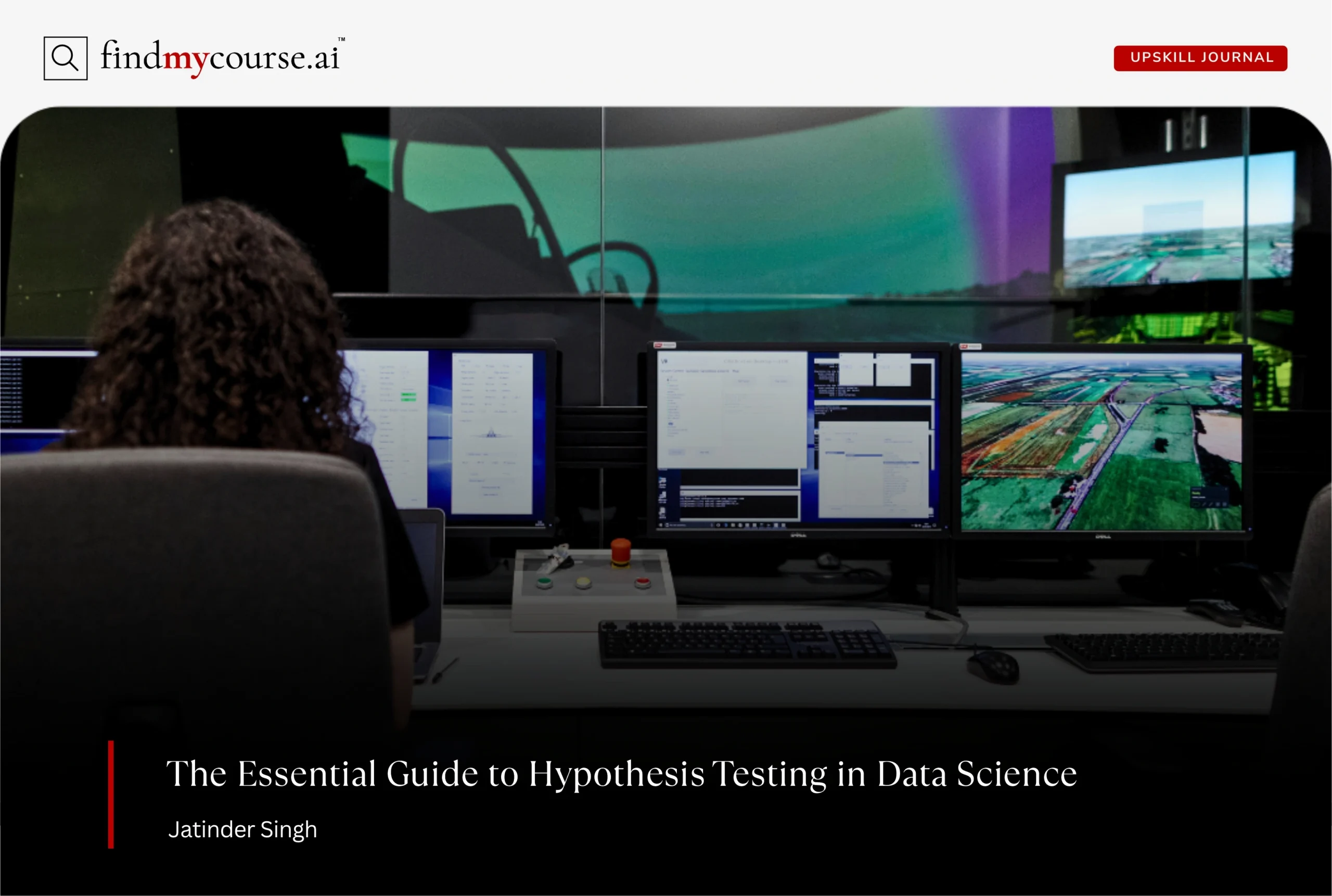In the fast-paced world of data science, decisions can’t rest on hunches. Professionals and organizations thrive when they use structured methods to validate insights. That’s where Hypothesis Testing steps in. Whether you’re analyzing customer behavior, optimizing business strategies, or verifying machine learning models, hypothesis testing provides the backbone of evidence-based decision-making.
For professionals eager to upskill in data-driven roles, mastering hypothesis testing is more than just a technical exercise—it’s a way to think critically, reduce bias, and build credibility in your work. This guide unpacks what hypothesis testing really means and how you can apply it to your career journey.
What is Hypothesis Testing
Hypothesis testing is a statistical method that evaluates an assumption about a population using sample data. Simply put, it asks: “Does the data provide enough evidence to support or reject my assumption?”
The process involves three steps:
- State the hypotheses – The null hypothesis (H₀) assumes no effect, while the alternative hypothesis (H₁) suggests an effect exists.
- Collect and analyze data – Draw a sample, apply the appropriate statistical test, and calculate results.
- Draw a conclusion – Use probabilities and thresholds (like p-values) to decide whether to reject or accept H₀.
Think of it as applying the scientific method to practical questions. Instead of guessing if a marketing campaign increased sales, hypothesis testing shows whether the improvement is real or random.
In data science, hypothesis testing acts like a compass, keeping professionals anchored in measurable evidence. Its importance lies in three areas:
- Data-Driven Decisions: It turns business debates—like “Did the new feature boost retention?”—into evidence-backed answers.
- Risk Reduction: From drug trials to pricing strategies, it prevents costly mistakes by validating results before action.
- Career Growth: Mastering hypothesis testing strengthens problem-solving skills and credibility, helping professionals upskill and become trusted decision partners.
In essence, hypothesis testing transforms raw data into reliable insights that drive smarter choices.
Key Components of Hypothesis Testing
To truly understand what is hypothesis testing, it helps to break down its core components. Think of these as the building blocks that give the process structure, reliability, and meaning. By mastering them, you not only learn the mechanics but also gain the confidence to apply hypothesis testing responsibly in real-world scenarios.
1. Null and Alternative Hypotheses
Every test begins with two competing statements:
- Null hypothesis (H₀): This assumes there is no effect, no difference, or no relationship. For example, a company might assume that changing the color of a website button does not affect conversion rates.
- Alternative hypothesis (H₁): This challenges the null, suggesting there is an effect or difference. In our example, H₁ would claim that the button color does influence conversions.
This step sets the stage—it’s the foundation on which the rest of the test is built.
2. Test Statistics
Once data is collected, a test statistic is calculated. This number represents how far the observed results deviate from what the null hypothesis would predict. Imagine flipping a coin 100 times: if you get 70 heads, your test statistic shows whether this result is close enough to what you’d expect (around 50) or too unusual to ignore.
3. P-Value
The p-value translates your test statistic into a probability. It answers the question: If the null hypothesis were true, what is the chance of seeing results this extreme?
- A small p-value (commonly below 0.05) means your results are unlikely under H₀, giving you evidence to reject it.
- A larger p-value suggests the data is consistent with H₀, so you stick with it.
Think of the p-value as a measure of “surprise.” The lower it is, the more your data surprises the null hypothesis.
4. Significance Level (α)
Before you run the test, you set a significance level, often written as α (alpha). This is your personal cutoff for how much risk you’re willing to accept in being wrong. The standard choice is 0.05, meaning you’re comfortable with a 5% chance of making a wrong decision.
In practice, α is like drawing a line in the sand. If your p-value falls below that line, you reject H₀. If not, you hold onto it.
5. Errors in Testing
No test is flawless, and recognizing possible errors keeps your interpretations grounded.
- Type I Error (False Positive): You reject H₀ even though it’s actually true. For example, concluding that a new drug works when it really doesn’t.
- Type II Error (False Negative): You fail to reject H₀ when H₁ is true. This would be like overlooking a treatment that actually helps patients.
Balancing these risks is essential in data science. Too strict, and you may miss meaningful discoveries. Too lenient, and you may draw false conclusions.
Understanding these components turns hypothesis testing from a mechanical checklist into a powerful reasoning tool. Each part—hypotheses, statistics, probabilities, thresholds, and error awareness—works together to ensure your conclusions are not only mathematically sound but also practically meaningful.
Applications of Hypothesis Testing in Data Science
Now that we know what hypothesis testing is, let’s explore its real-world applications in data science.
| Application Area | How Hypothesis Testing is Used | Example in Practice | Tools / Resources | Benefit |
| A/B Testing in Marketing | Compare two or more versions of ads, websites, or campaigns | Testing two landing page designs to see which drives more sign-ups | Optimizely, Python (SciPy, Pandas) | Provides data-backed evidence to optimize campaigns and boost ROI |
| Machine Learning Model Validation | Verify assumptions about datasets or feature importance | Checking if adding a new feature improves prediction accuracy | Python (statsmodels, scikit-learn), R (caret, stats) | Prevents overfitting and ensures models generalize |
| Product Development Decisions | Evaluate customer response to new features | Measuring if an AI recommendation tool improves satisfaction | Tableau, Power BI, Python (pandas, matplotlib) | Reduces risk by validating impact before large rollout |
| Healthcare Research | Test whether treatments improve outcomes | Checking if a new drug reduces blood pressure more effectively | SPSS, R, Python (scipy.stats) | Ensures results are statistically and ethically robust |
| Policy and Social Research | Analyze impact of programs | Assess if a job-training program improves employment outcomes | R, Python, government open datasets | Helps policymakers make evidence-based decisions |
| Operations Optimization | Evaluate process or efficiency changes | Testing if a new scheduling system reduces delivery delays | Python, Excel, Tableau | Enhances productivity and lowers operational costs |
Steps to Perform Hypothesis Testing in Data Science
Mastering hypothesis testing requires following a logical and disciplined workflow. Each step builds upon the last, guiding you from curiosity to actionable conclusions. Here’s a clearer, more detailed roadmap:
1. Define the Question Clearly
Every great analysis begins with a sharp question. Instead of asking, “Does my product work better?” frame it precisely: “Does the new feature increase average user engagement compared to the old one?” Clarity here prevents wasted time and ensures results directly address business goals.
2. Formulate Hypotheses (H₀ and H₁)
Next, you translate your question into testable assumptions:
- Null Hypothesis (H₀): Assumes no difference or effect.
- Alternative Hypothesis (H₁): Suggests a meaningful difference or effect exists.
For instance, H₀: “The new feature does not change engagement time.” H₁: “The new feature increases engagement time.”
3. Choose the Right Test
Not all data is created equal. The right statistical test depends on the type of data and the question:
- T-tests: Compare two groups (e.g., average time on site for two user groups).
- Chi-square tests: Examine relationships between categorical variables.
- ANOVA: Compare means across more than two groups.
Choosing wisely ensures results are valid and interpretable.
4. Set Significance Level (α)
Before analyzing, decide how much risk of error you’re willing to accept. The common choice is α = 0.05 (5%). This means you’re okay with a 5% chance of wrongly rejecting H₀. Setting α upfront keeps decisions objective instead of swayed by personal bias.
5. Collect and Analyze Data
Now, gather your sample data carefully—it should represent the population you want to study. Run the chosen test and compute your test statistic. This step transforms raw data into evidence that can be weighed against expectations.
6. Interpret Results
Compare the p-value against your chosen α:
- If p ≤ α, reject H₀ and accept that evidence supports H₁.
- If p > α, fail to reject H₀, meaning the data doesn’t show strong enough evidence.
Interpretation requires balance—avoid overstating results, and consider the possibility of Type I or Type II errors.
7. Draw Business Conclusions
Statistics are only powerful when they inform decisions. Translate your findings into actionable insights. For example, if results show the new feature boosts engagement significantly, recommend rolling it out. If not, advise holding back resources.
By walking through these steps with discipline, you ensure that hypothesis testing is not just a technical process but a reliable bridge between data and meaningful business outcomes.
Conclusion
Hypothesis testing is where data meets decision. From reducing risks to shaping strategies, it ensures choices are backed by evidence, not assumptions. For professionals, it’s not just a technical skill but a career advantage—one that proves your insights, builds trust, and drives real impact. Embrace it as the final step in your analysis and the first step toward smarter, more confident decisions. And if you need any help exploring this topic or have questions, feel free to ask our AI assistant for guidance.


